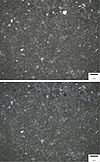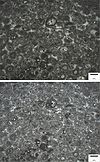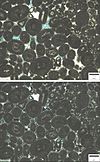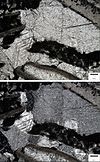- Dunham classification
-
The Dunham classification system for carbonate sedimentary rocks was devised by Robert J. Dunham in 1964, and refined by Embry and Klovan in 1971 to include sediments that were organically bound during deposition.
Contents
History
Robert J. Dunham published his classification system for limestone in 1962. His scheme focuses on the depositional fabric of carbonate rocks. Dunham divides the rocks into four main groups based on relative proportions of coarser clastic particles. Dunham names are essentially for rock families. His efforts deal with the question of whether or not the grains were originally in mutual contact; and therefore self-supporting, or whether the rock is characterized by the presence of frame builders and algal mats. Unlike the Folk classification scheme, Dunham deals with the original porosity of the rock. The Dunham scheme is more useful for hand samples because it is based on texture not the grains in the sample
Dunham classes
The classification is a way of describing the composition of calcareous rocks. For descriptions detailing the textural components of sediments and sedimentary rocks, the Folk classification is generally preferred - both are equally valid methods of classification with different emphases.
- Mudstone contains less than 10% grains (usually assessed by area in cut or thin section), supported by a lime mud.
- Wackestone consists of more than 10% grains, supported by a lime mud.
- Packstone contains lime mud, but is grain supported.
- Rudstone is coarse limestones supported by grains larger than 2 mm.
- Grainstone lacks mud, and is grain supported.
- Floatstone contains over 10% >2mm grains but is matrix supported
- Boundstone describes sediment where the original components have been bound together after deposition.
- Bafflestone develops where organisms have acted as baffles during deposition, reducing the local depositional energy. They will contain traces of baffling organism and smaller grains that would be expected from the paleocurrent strength.
- Bindstone is produce where organisms (such as algae) encrust the elements during deposition and bind them together.
- Framestone is a solid calcareous or siliceous framework which is maintained by an organism such as a coral or sponge.
- Crystalline carbonate does not have recognisable depositional structures.
Summary
Dunham Mudstone Wackestone Packstone Grainstone Boundstone Crystalline Frame Less than 10% grains, more than 90% mud More than 10% grains, less than 90% mud Grain supported Grain supported Grain or mud supported Crystal supported Mud Mud supported, Mud supported Less mud No mud With or without mud No grains or mud Deposition
cementationOriginal components not bound together during deposition Original components not bound together during deposition Original components not bound together during deposition Original components not bound together during deposition Bound during deposition Depositional figures not recognizable Thin section References
- Dunham, R. J. (1962). "Classification of carbonate rocks according to depositional texture". In Ham, W. E.. Classification of carbonate rocks. American Association of Petroleum Geologists Memoir. 1. pp. 108-121.
External links

This article related to petrology is a stub. You can help Wikipedia by expanding it.




